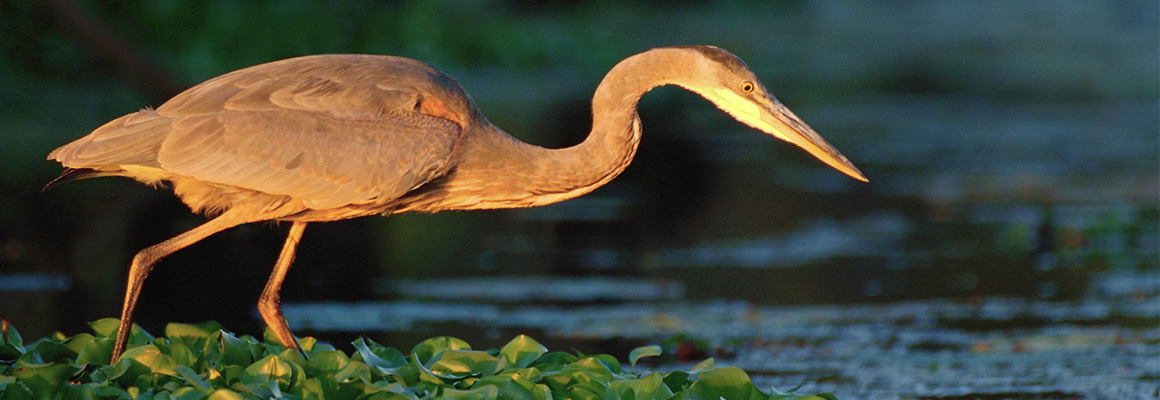protecting wetlands and forestlands

Since about two-thirds of Chevron’s 3,000-acre property in Jackson County is wetlands and forestlands, the refinery is home to nearly all species of wildlife indigenous to the Gulf Coast. Take a look at this list of some of our refinery residents, or animals that call the refinery home.
The coexistence of the deer, raccoons, foxes, waterfowl and fish with our refinery operations is a tremendous source of pride for Chevron and its employees. This sense of pride provides additional incentive for employees to take special care in following environmental regulations when operating our plants and when replacing (or mitigating) wildlife habitats impacted by plant expansions.
We are proud of the four successful wetland mitigation sites the refinery constructed to replace those used in plant expansions. The sites are often included in refinery tours, and the North Mitigation Area is showcased by the Mississippi State Coastal Research & Extension Center as an exemplary constructed inter-tidal saltwater marsh.
north mitigation area
(saltwater marsh)
When Chevron expanded refinery operations in the early 1980s, we constructed about 25 acres of salt marsh wetlands to replace (or mitigate) property used for the expansion. Pine flatwood uplands were excavated, and a centrally located tidal creek was built and connected to the tidal waters of the Bangs Lake estuary. The site includes a low marsh zone dominated by Smooth Cordgrass, a mid-marsh zone dominated by Needle Rush, and a high marsh salt panne zone. Some of the fish, shellfish, mammals, and birds that live in or visit the area are white shrimp, blue crabs, mullet, flounder, marsh rabbit, raccoon, muskrat, mink, clapper rail, great blue heron, great egret, red-winged blackbird, red-tailed hawk, northern harrier hawk, willet, and hooded merganser.
The North Mitigation Area was the site of a Corps of Engineers-funded study conducted from 1992-1995 by Mississippi State University’s Coastal Research & Extension Center that compared a constructed marshland to a natural habitat. Calling the refinery’s mitigation project a success, the study’s 1995 report said the constructed area’s numbers and types of fish, shellfish, birds and plants are comparable to those of a natural estuarine saltwater marsh.
south mitigation area
(freshwater marsh)
Also in the mid-1980s as part of the mitigation for the Pascagoula Residuum Conversion Project, 15 acres of pine wood flatlands were flooded to create a freshwater marsh. Over time the rising water table in the flooded section killed the pine trees, which greatly reduced the overhead canopy. Plant community characteristics that resulted from this change in canopy cover and hydrology now closely duplicate the flora found in freshwater marshes. Some examples of the animals and birds that now seasonally visit or live in this area are alligators, otters, raccoons, nutria, red fox, marsh rabbits, snowy egrets, reddish egrets, glossy ibis, green herons, great blue herons, scarlet tanagers, mottled ducks, and fresh water turtles.
north woods mitigation area (bottom-land hardwood swamp)
Site alterations in drainage on 26 acres of mixed pine and hardwood forest in 1993 have converted this area into a partially inundated (flooded) open canopy/bottom-land hardwood swamp. The site was created as mitigation for the refinery’s Aromax Project. Dikes were constructed along the lower borders of this area to trap periodic run-off from rain events. Additionally, several ponds and a canal were built and stocked with bass and bluegill to enhance the area’s wetland performance. Since 1993 the canopy layer has been shifting from a dominant slash pine canopy, to a mixed hardwood open canopy composed primarily of water oak, cypress, red maple, and black gum. The mixed under-story is composed of ferns, sedges, rushes, and grasses. Some of the wildlife that live or visit at this site are alligators, white-tailed deer, otters, snapping turtles, great horned owls, wood ducks, ospreys, pileated woodpeckers, belted kingfishers, bald eagles, leopard frogs, raccoons, tri-colored herons, and great egrets.
out-fall canal mitigation area (Shoreline beach restoration)
In 1994 a fixed weir was installed across the mouth of the refinery’s Out-fall canal to meet certain requirements of the Clean Water Act. (The Out-fall canal is the effluent waterway that transports the Refinery’s treated wastewater to its discharge point in the Mississippi Sound.) As mitigation for the project, a breakwater was built to restore and to protect rapidly eroding shoreline on the western side of the weir, at the edge of the Mississippi Sound. As a result of the breakwater, approximately 800 feet of inter-tidal marsh/low dune shoreline has been protected from erosion, and 52,000 square feet of shallow bay bottom has been converted to inter-tidal marsh. Protected openings in the breakwater allow access to the marsh area by fish and shellfish during high tide events and promote the accumulation of sediments to replace those lost by erosion. Examples of some of the animals and birds that seasonally visit or live in this area are white and brown pelicans, snowy egrets, ospreys, black-necked stilts, blue crabs, oysters, raccoons, great blue herons, great egrets, marsh rabbits, sea-side sparrow, and cormorants.
rhodes lake mitigation area (partnership with international paper)
In addition to the above on-site mitigation areas we have also partnered with International Paper in a wetlands restoration project at the Rhodes Lake Mitigation Area in Moss Point. This 915-acre site is owned by International Paper and the wetland quality has been adversely affected by historical uses and tidal action from tropical systems like Hurricane Katrina. In 2008 we partnered with International Paper to fund the restoration of this ecosystem to a riverine and bottomland hardwood forest ecosystem in exchange for future mitigation credits at our refinery.